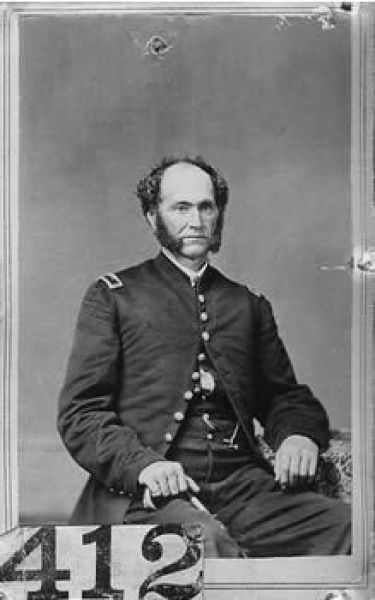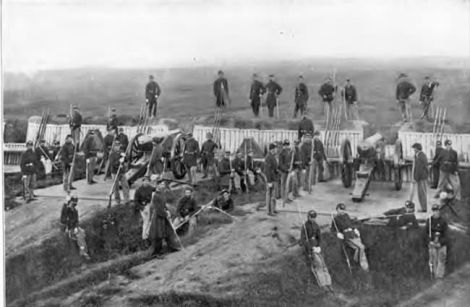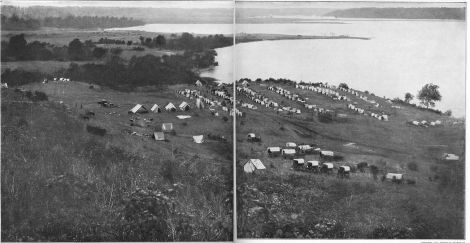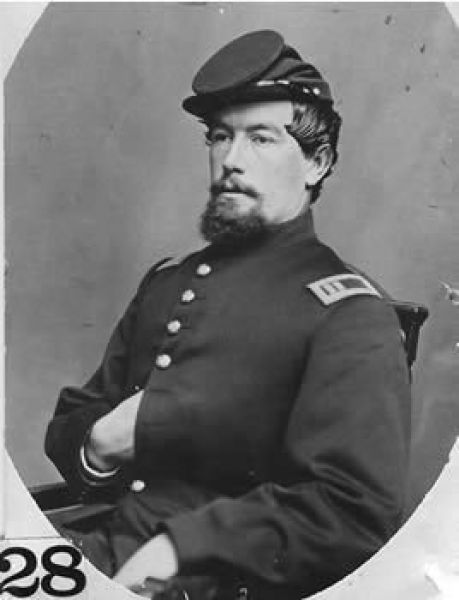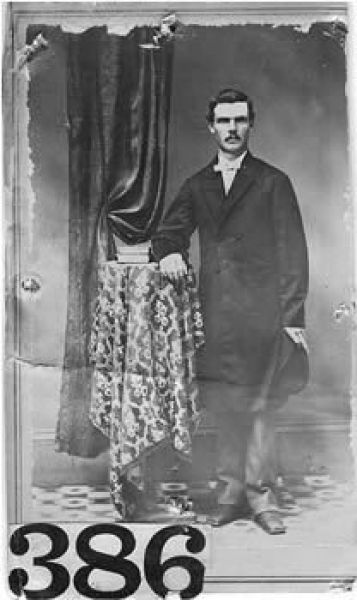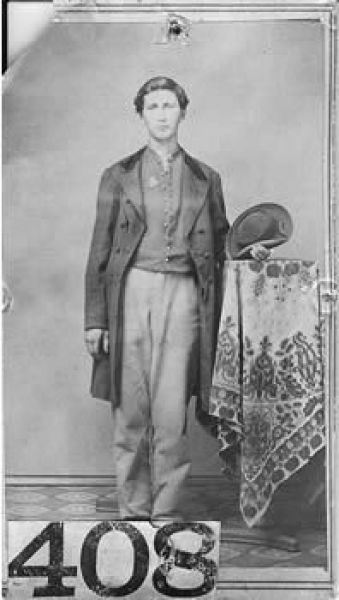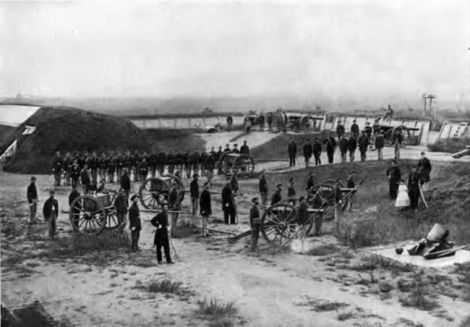2nd Heavy Artillery Regiment
Nickname: Governor Morgan's Second Regiment United States Light Artillery; Palmer's Artillery; Latson's Artillery
Mustered in by companies: August 23 to December 12, 1861
Mustered out: September 29, 1865
The following is taken from New York in the War of the Rebellion, 3rd ed. Frederick Phisterer. Albany: J. B. Lyon Company, 1912.
Col. John W. Latson received authority from the War Department, July 24, 1861, to recruit a regiment of artillery; of this the National Union Rangers formed part. Col. Jeremiah Palmer received authority from the Governor of the State to recruit a regiment of artillery, known as Governor Morgan's Light Artillery. August 24th Colonel Latson's authority was revoked, and October 18th these two organizations were consolidated, forming eight companies, and the new organization designated the 2d Regiment of Artillery. Captain Maguire's company of the Latson Artillery became Company A; the companies of Captains Kitching, Hogg, Jones, Klinck, Houseman, Clarke and Smith, became Companies B, C, D, E, F, G and H, respectively. December 5, 1861, there was assigned to the regiment, completing its organization, the so-called third battalion of the Morgan Artillery and the Flushing Artillery. The companies of Captains Griffin, Joslin and Halstead, of the Morgan Artillery, became Companies I, K and M, and the Flushing Artillery, Capt. Thomas L. Robinson, Company L; the men of Company M of the Morgan Artillery were assigned to Companies I and M. The regiment was organized at Staten Island for a service of three years. The companies were mustered in the United States service at Staten Island, A and E October 2; B August 23; C and D September 18; F, G and H October 15; I and K December 11; L November 18; M December 12, 1861. In June, 1862, a number of Indians, members of Company F, were discharged. November 19, 1863, Battery L, which served detached from the regiment since March, 1862, as a light battery, was permanently detached and became the 34th Battery; it was replaced by a new company in January, 1864. At the expiration of its term of service, those entitled thereto were discharged, and the regiment retained in the service. June 27, 1865, the regiment was consolidated into eight companies, the men of Company I being transferred to Companies A and E; those of K to A, C and F; of L to B, C, D and H; and of M to A, G and H; and the members of the 9th Artillery, not discharged on the muster-out of their regiment, were transferred to it as Companies I, K, L and M.
The companies were recruited principally: A (Company B of John W. Latson's Regi-ment of Light Artillery, Horse Artillery, 1st Regiment U. S. Volunteers), on Staten Island; B (1st Regiment Heavy Artillery), on Staten Island; C, D, E and F, at New York city; G at Utica; H (Carthage Battery), at Waterloo and Carthage; I, formed partly of Latson's Light Artillery and the Morgan Artillery at New York city and Norwich; K (Morgan Artillery), at Frankfort, Mohawk, Tompkinsville and Herkimer; L (Flushing or Hamilton Light Artillery, originally Artillery Company, 15th Militia), at Flushing; and M (Morgan Artillery), at Utica, Little Falls, Trenton Falls, Russia, Taberg, Camboy, Holland Patent, Rochester and Sand Bank. The second Company L was recruited principally at Frankfort, Schuyler, Hamilton, German Flats, Richfield, Warren, Utica, Exeter, Camden, Stark, Otsego, Burlington, Norwich and Watertown.
The first eight companies left the State November 7, 1861; Company L December 2d; and Companies I, K and M December 12, 1861; and the regiment (except first Company L for which see 34th Battery) served at and near Washington, D. C., in the Military District of Washington, from March, 1862; in Sturgis' Brigade, Military District of Washington, from May, 1862; in the Reserve Corps, Army of Virginia, from June, 1862; in the defenses of Washington, from September, 1862; in the artillery defenses of Alexandria, from January, 1863; and in the 22d Corps from February, 1863; in Tyler's Artillery Division, 2d Corps, Army of Potomac, from May 18, 1864; in the 2d Brigade, 1st Division, 2d Corps, from May 29, 1864; in the 1st Brigade, 1st Division, 2d Corps, from July, 1864; in the 1st Brigade, DeRussy's Division, 22d Corps, from June, 1865, as heavy artillery and infantry. September 29, 1865, commanded by Col. Joseph N. G. Whistler, it was honorably discharged and mustered out at Washington, D. C.
During its service, the regiment lost by death, killed in action, 5 officers, 105 enlisted men; of wounds received in action, 5 officers, 101 enlisted men; of disease and other causes, 250 enlisted men; total, 10 officers, 456 enlisted men; aggregate, 466; of whom 71 enlisted men died in the hands of the enemy.
The following is taken from The Union army: a history of military affairs in the loyal states, 1861-65 -- records of the regiments in the Union army -- cyclopedia of battles -- memoirs of commanders and soldiers, Volume II: New York, Maryland, West Virginia and Ohio. Madison, WI: Federal Pub. Co., 1908.
Second Artillery.—Cols., Jeremiah Palmer, Gustave Wagner, Milton Cogswell. Joseph N. G. Whistler; Lieut.-Cols., Oscar F. Hulser, Henry B. Burtnett, Henry P. Roche, Gustave Wagner, Jeremiah Palmer, George Hogg; Majs., Henry P. Roche, Albert Bronson, Thomas McGuire, George Hogg, Benjamin Van Raden, Alexander Doul, George S. Dawson. Edward A. Selkirk, William A. McKay, Pliny L. Joslyn, Thomas J. Clark, Oscar F. Hulser, Sullivan B. Lamoreaux, Francis R. Humphreys. This regiment was known as Gov. Morgan's 2nd regiment U. S. light artillery, or Palmer's artillery. Eight of its companies were recruited prior to Oct. 18, 1861, by Cols. John W. Latson and Jeremiah Palmer, and to these were added on Dec. 5, 1861, the Morgan and the Flushing artillery, completing the regimental organization. The companies were raised in the counties of New York, Oneida and Herkimer and the regiment was organized at Staten island, where it was mustered into the U. S. service by companies, between Aug. 22 and Dec. 12, 1861, for three years. Thirty-four Indians of the Oneida tribe, original members of Co. F, were discharged in June, 1862. Original Battery L, which had served detached as light artillery, became the 34th Battery (q. v.) in Nov., 1863, and was replaced by a new battery in Jan., 1864. On the expiration of their term of service the original members were mustered out, and the regiment, composed of veterans and recruits, remained in service. On June 27, 1865, it was consolidated into eight companies, and four companies of the 9th N. Y. artillery were transferred to it as Cos. I, K, L and M. The first eight companies left the state on Nov. 7, 1861, and the remaining companies about a month later. Early in the war the regiment garrisoned Forts Ward, Worth and Blenker—the advanced line of Washington defenses on the Virginia side of the Potomac. At the time of the enemy's raid upon Manassas in Aug., 1862, it did splendid service at Bull Run bridge and was the means of saving the remainder of Gen. Taylor's New Jersey brigade, holding the enemy in check while the New Jersey troops and the 12th Pa. cavalry made good their retreat. Its loss in this action was i killed, 6 wounded and 53 missing. The regiment fought bravely during Grant's campaign of 1864 and during the final Appomattox campaign. It was assigned to Tyler's artillery division, 2nd corps, on May 18, 1864, and afterwards served in Barlow's division of the same corps. It took part in the engagements at Spottsylvania, the North Anna, Totopotomy, Cold Harbor, first assault on Petersburg, Weldon railroad. Deep Bottom, Strawberry Plains, Reams' station, Hatcher's run. Fort Stedman, White Oak ridge, fall of Petersburg, Deatonsville, High bridge, Farmville and Appomattox Court House. Its losses were particularly heavy at Spottsylvania—117 killed, wounded and missing. At the Totopotomy and North Anna it lost 95 killed, wounded and missing; at Cold Harbor 215; at the first assaults on Petersburg, 306; at Strawberry Plains, 60; at Reams' Station, ^2; and during the final assault on Petersburg, 104. There were nine heavy artillery regiments whose loss in killed and died of wounds exceeded 200, among which the 2nd N. Y. ranked eighth. In the assault on Petersburg, June 17. 1864, the 2nd lost 54 killed, which is one of the most remarkable losses sustained by a heavy artillery regiment in any one engagement during the war. Its total losses were 216 killed and mortally wounded, 10 of whom were officers; 250 enlisted men died of disease, accidents, in prison, etc.; total deaths, 466. There were 27 officers and 718 enlisted men wounded (including 106 mortally wounded and 71 enlisted men died as prisoners. It was mustered out at Washington, Sept. 29, 1865, commanded by Col. Whistler.
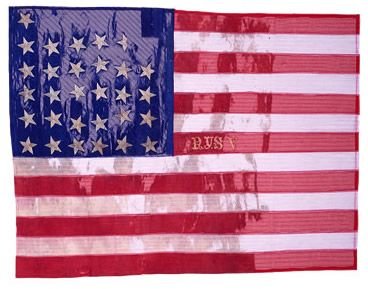
2nd Regiment Artillery (Heavy), NY Volunteers | National Flag | Civil War
This flag attributed to the 2nd Regiment Artillery, New York Volunteers, currently includes only 30 embroidered stars from either a 35, or 36-star…
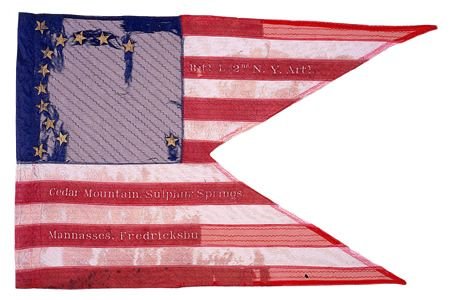
Battery L, 2nd Regiment Artillery (Heavy), NY Volunteers | Guidon | Civil War
Approximately 50% of this silk guidon is missing including a large part of the canton and portions of the battle honors commemorating the battery’s…
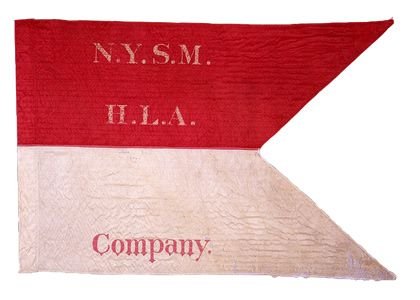
Hamilton Light Artillery | Guidon | Civil War
Captain Thomas Robinson, commander of the "Hamilton Light Artillery" company from the 15th New York State Militia, received authority in July 1861 to…

Battery L, 2nd Regiment Artillery (Heavy), NY Volunteers | Guidon | Civil War
Captain Thomas Robinson, commander of the "Hamilton Light Artillery" company from the 15th New York State Militia, received authority in July 1861 to…
NYSMM Online Resources
Battles and Casualties from Phisterer (pdf)
Battles and Casualties from Phisterer (spreadsheet)
Camp Of Heavy Artillery On The Way To Petersburg

